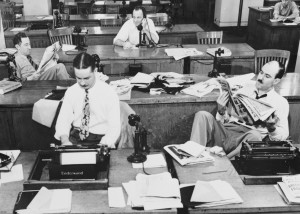 This morning I spent 45 minutes cutting an article by a technology marketer by one-third. When I finished, the piece was better than when I started. And that made me happy.
This morning I spent 45 minutes cutting an article by a technology marketer by one-third. When I finished, the piece was better than when I started. And that made me happy.
I love editing, and I’m not ashamed to admit it. I also love my occasional roles as speaker, prognosticator and thought leader, but there’s something uniquely satisfying about taking someone else’s work and making it better.
Editors get little credit for what they do, but like film directors and record producers, their function is essential to a quality product. Today they are more needed than ever.
I sat down to write this essay after reading Alexandra Samuel’s eloquent post on the HBR blog network. Content marketing, she writes, “has emphasized producing a high volume of content at the expense of producing content that people actually want to consume.” But repetitive, unremarkable content drives audiences away, which is the opposite of what marketers want to achieve. The solution is better editing.
There are three types of editors: visionaries, copy editors and line or content editors. Marketing departments have no shortage of visionaries. They can also hire hourly workers to sweat the details of grammar and punctuation.
What’s missing are the editors in the middle, the city editors, the people who shape individual stories and work with writers to turn ideas into content that people want to consume. In a world where everyone is a content producer but few people know how to write, they are in desperately short supply.
There are a lot of misconceptions about line editors. I’ll address a few big ones:
Editors work mostly with copy.
This is true only if the editors are incompetent or their organization is screwed up. Good editors do 90% of their work before a single word is written. They take ill-formed ideas and shape them with interesting angles and approaches. They guide writers on sourcing, structure, voice and format. They know when more research is needed and also when to stop researching and start writing.
Editors take words out.
This is sadly truer than it should be. People are taught from their earliest school days to equate length with gravity, so overwriting in the business world is epidemic. Sometimes the solution is to take words out, but it’s often better to rephrase ideas so that fewer words say the same thing. Editing is also about knowing where gaps exist and directing the content creators to gather more information.
Bill Blundell’s The Art and Craft of Feature Writing should be required reading for all editors. A longtime Wall Street Journal writer and editor, Blundell documents the almost obsessive culture at that newspaper with packing more information into less space. The reason for taking words out, though, is to fit more information in. The Journal’s time-pressed audience wants efficiency, not just brevity.
The editor’s most important constituency is the people who create the content.
Wrong. Good editors advocate tirelessly for the people who consume the content. They need to know better than anybody about the knowledge level, interests and time constraints of the audience, and they need to remind content creators, who tend to fall in love with their own work, that ultimately there is someone on the other end reading or watching. The best editors have spent years in the field with their constituents and continue to speak to them every day.
Editing is a thankless task.
It’s an anonymous task, but hardly a thankless one. Editors take pride in seeing a product they can be proud of. They also love to see the writers, photographers and broadcasters they work with blossom in their own right. One of my most rewarding moments was seeing a writer whose crude skills I had helped shape years ago receive a Nieman Fellowship.
Finally, editors take pride in knowing that their work has benefited their audience. No one will know or care that I cut 350 words from a marketer’s overwritten article this morning, but I’ll know that my time investment saved each person who read it a couple of minutes. And perhaps they understood it better, too. That’s reward enough.

Amen, Paul, Amen! For me, the best part about editing was the all the “pre” editing work – helping people shape ideas, come up with art ( don’t know why people struggle with that so much – I thought it was easy, and a way to shoehorn in the info that wasn’t going to make your inch count.), organize their material, even helping them come to a news meeting with a better fleshed out idea than first pitched in the news log (a major time saver down the road). As for the actual editing – the best part was knowing you’d taken a story with issues and molded it into a page 1 piece. This is especially important if you are working with someone who you know will get the story (really, their primary responsibility), but isn’t the greatest writer. And in those cases, requiring an outline, followed by a draft, went a long way in saving editing angst and precious time later. It helps the writer too – do it often enough and they start doing it automatically.
You’re certainly qualified to comment, Tish. You’re one of the best editors I’ve worked with.